Engraving depicting the furnishings of the Secretary of the Treasury, c.1865

Furnishing a government office building was not new to Supervising Architect Alfred B. Mullett. In 1864, while he served as the assistant to then Supervising Architect Isaiah Rogers, Mullett was charged with furnishing the Secretary of the Treasury’s offices. For this commission, Mullett hired the New York firm of Pottier & Stymus to provide the furniture and decoration for the new Secretary’s office when it was relocated to Treasury’s newly constructed West Wing. Upon completion, the newly furnished Secretary’s office was not well received. On February 1, 1864, Secretary Salmon P. Chase wrote to Mullett that he found his new Treasury space, “entirely too ornate for [a] Public Office and a violation of the Republican simplicity I desire to observe in finishing and furnishing this building.” While Mullett was initially rebuked by the Secretary of Treasury, this did not prevent him from maintaining an abiding interest not only in the planning and construction of Federal buildings, but also in their furnishings.
Entrance of the Old San Francisco Mint Building
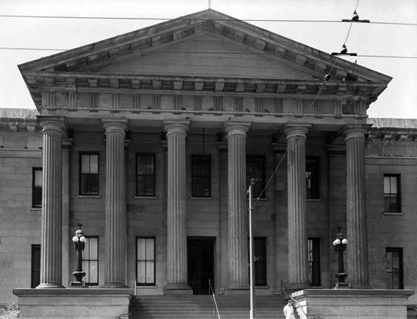
Alfred Mullett and the Office of the Supervising Architect’s role in furniture design and procurement is particularly well documented in the 1874 furnishing of the newly constructed San Francisco Mint. In his capacity as the Supervising Architect, Mullett assumed complete responsibility for the design, construction and procurement of furniture for what was then one of the Treasury’s most important buildings.
Architects sketchbook of furniture designs
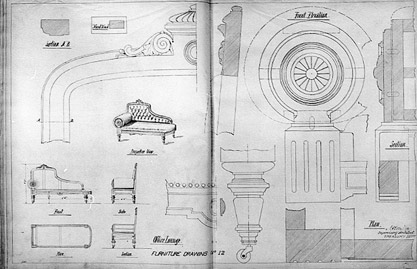
A construction superintendent’s letter documents the process and detail that went into the procurement and manufacturing of furniture for a Federal building. Mullett‘s had previously sent “specifications, drawings and photographs,” to the Superintendent revealing the Supervising Architect’s design process as well as his methodology in the furniture procurement. While the written specifications and photographs of the individual pieces of furniture have not been located, the Supervising Architect’s designs do survive. Compiled in a published folio entitled, “Drawings of Standard & Post Office Furniture for Public Buildings” and date stamped “1878,” the designs represent furniture that the Supervising Architect designed specifically for Post Offices intermingled with more generic designs that could be used for other government buildings.
Sketchbook Folio of Furniture Designs by the Supervising Architects Office
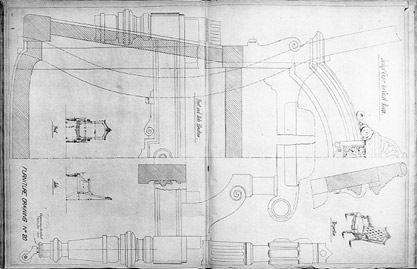
The furniture portfolio follows eighteenth & nineteenth-century design book convention in providing working drawings for cabinetmakers, furniture manufacturers and upholsterers. Each page of the book illustrates a particular form of furniture, with the drawings not only for the completed work, but also, in several instances, the method of construction or upholstery.
Supervising Architects Office Furniture Design Sketchbook

This design folio documents a design practice followed by the Supervising Architect’s office as their workload intensified. By the 1860s it had become routine for the Supervising Architect’s office in Washington to print multiple copies of sets of architectural drawings for a wider distribution than the building at hand. The furniture book was printed in a similar manner and was also intended for multiple clients as well as furnishings specified for use in post offices.
San Francisco Mint Prototype Desk Restored
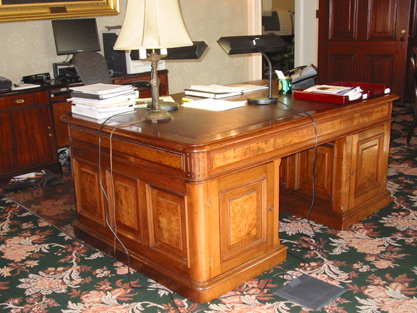
In addition to the drawings and photographs of furniture designs, a prototypical desk was also shipped to San Francisco for examination. The desk survives in the Treasury collection and bears the stencil of Harrington & Mills of Baltimore, Maryland. Similar to the desks depicted in the folio, the labeled example has an elevated reading lift directly above the kneehole. This feature is typically found on the 1870s desks with a San Francisco provenance that survive in the Treasury collection.
Stencil detail from the S.F. Mint prototype desk
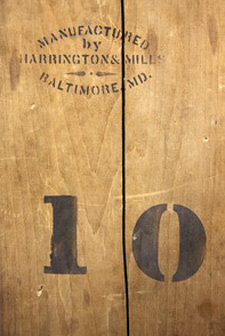
The prototype would have provided the West Coast cabinetmakers with both the construction detail as well as a standard of finish for the fabrication of similar examples. The drawings and specifications would have provided information on related contractual items, thereby achieving a unity in the furnishings of a government office as previously emphasized in Mullett’s 1870 Supervising Architect’s report.
19th Century Furniture Company Catalog

While the actual photographs send to San Francisco during construction noted in Mullett’s letter do not survive, other comparable period photographs do exist. Of particular interest and applicable to San Francisco at this time are the photographic illustrations from the California Furniture Manufacturing catalogue from circa 1872-1880s. The catalogue’s photograph of chairs, for example, shows three examples, methodically numbered for purchase by a perspective client. The Supervising Architect office employed a photographer who was certainly capable of producing similar images. In fact, the photographer’s studio where such photograph’s would have been produced, was designed by the Supervising Architect’s office, Mullett’s original approved drawing preserved in the Treasury collection.
